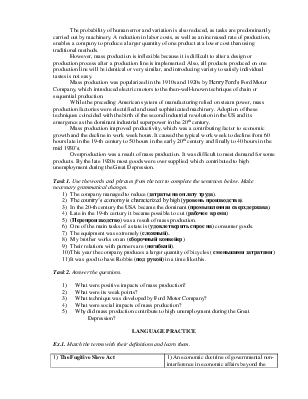







UNIT 6
ECONOMIC AND POLITICAL DEVELOPMENTS
IN GREAT BRITAIN AND THE USA IN THE 18-th and 19-th CENTURIES
LIST OD WORDS
to arrive at (a compromise)
widening of the gap
birth rate
boost in population
secession
to abolish slavery
to encourage trade
to expand private / public sector
to introduce (new methods)
backward / advanced technology
industrial revolution
urban/ rural population
productive forces
division of labor
mass production
assembly line
laisser-faire
the leading producer
skilled labor
to introduce new machinery
fair wages
work / working hours
safe working conditions
social effects of the industrial revolution
labor costs
at a lower cost
union movement
to bargain with employers
unemployment
to heal the wounds
to remove smb. from office
petroleum industry
textile mill
unrestrained economic growth
to limit competition
toestablish control over (an industry)
to fix prices
restraint of trade
shipping rates
rate of production
to meet demand for (a product)
sophisticated
to have smb. at hand
TEXT 1. Read the text and translate the phrases in bold type into Russian. Answer the questions following the text.
The Industrial Revolution
The Industrial Revolution, which began in the British Isles and Western Europe, dramatically changed the nature of economic production. It is important not just as a historical episode, but because the pattern of economic development that it established has become in many ways a model for development worldwide.
Several elements were critical in creating the Industrial Revolution. First, new agricultural techniques, along with new kinds of tools and machines, made agriculture more productive. That meant that more agricultural output could be produced per worker and per acre of land. With productivity increasing, continuing and spreading across the globe, human populations could grow dramatically, reaching a first billion around 1810, and continuing to increase to the present global numbers of well over six billion. Because of the great increase in agricultural labor productivity, the number of workers needed to produce food for the rest of the population was shrinking even while the population as a whole was growing.
A second outstanding characteristic of the Industrial Revolution was the invention and application of technologies using inanimate sources of power and machinery for production of goods. Mechanization created jobs in factories, largely replacing the previous patterns of producing goods at home. Railroads and other advances in transportation, as well as the new kinds of work organization, made it possible to assemble large numbers of workers in factories, resulting in huge urban agglomerations.
Another important factor in England’s increasing industrialization was its ability to rely on other countries, including its extensive network of colonies, for supplies of raw materials and as markets for its goods.
An ever-increasing variety of things was produced in the emerging industrial sector. Some of these were items never seen before, such as bicycles, flushing toilets, machine-loomed cloth, communication by telegraph and steamships. Other products of industry were household goods, such as china dishes and cotton cloth, which had previously been used only by a small, rich elite. Others were, of course, the various kinds of machinery that were used to produce consumer items.
While the Industrial Revolution began in England, by the nineteenth and early twentieth century it was well along in much of Western Europe and other "early industrializing" countries such as the United States, Canada, and Australia. It is important not just as a historical episode, but because the pattern of economic development that it established has become the model for how development should proceed worldwide. The vocabulary of referring to rich countries as "developed" and poorer countries as "developing," for example, involves an implicit assumption that poorer countries are on a path of industrialization, on the road to perhaps eventually "catching up" to rich country lifestyles and levels of wealth.
1) What changes did the Industrial Revolution introduce in the pattern of economic development worldwide?
2) What elements contributed to creating the Industrial Revolution?
3) What do the notions "developed" and "developing" countries imply?
TEXT 2. Read the text and fulfill the tasks that follow it.
American Civil War (1861-1865)
Slavery in the United States first began in Virginia in 1619. By the end of the American War of Independence, most northern states
Уважаемый посетитель!
Чтобы распечатать файл, скачайте его (в формате Word).
Ссылка на скачивание - внизу страницы.